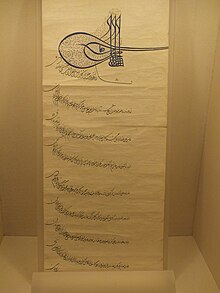Sinirname

A Sınırname was a type of document in the Ottoman empire, representing an area of land;[1] similar to a modern title deed, although often describing a larger area such as a village or district, rather than a single residence.[2]
A sınırname would be granted by a higher authority - even the sultan. It would describe the boundary of the land.[3] A sınırname might be issued like a land grant, or it might be issued following resolution of a border dispute[4] (for instance, by a kadi).
Sınırname also described land usage; they were parallel to the system of defters which were used for taxation.[5]
References[edit]
- ^ YOMRALIOĞLU; BIYIK. "Land Information Systems in 1500s" (PDF). FIG.XX International Congress: 5. Retrieved 28 October 2012.
{{cite journal}}: Cite journal requires|journal=(help) - ^ Glossary.doc "Glossary". ISLAM, LAND & PROPERTY RESEARCH SERIES. UN Habitat. Retrieved 28 October 2012.
{{cite web}}: Check|url=value (help) - ^ Parveva (June 2010). Village, town and people in the Ottoman Balkans: 16th-mid-19th century. p. 12. ISBN 9781617190988.
- ^ Archivum Ottomanicum. 24–25: 44.
{{cite journal}}: Missing or empty|title=(help) - ^ Keyder, Caglar; Keyder, Ça?lar; Tabak, Faruk (1991). Landholding and Commercial Agriculture in the Middle East. p. 20. ISBN 9780791405505.
